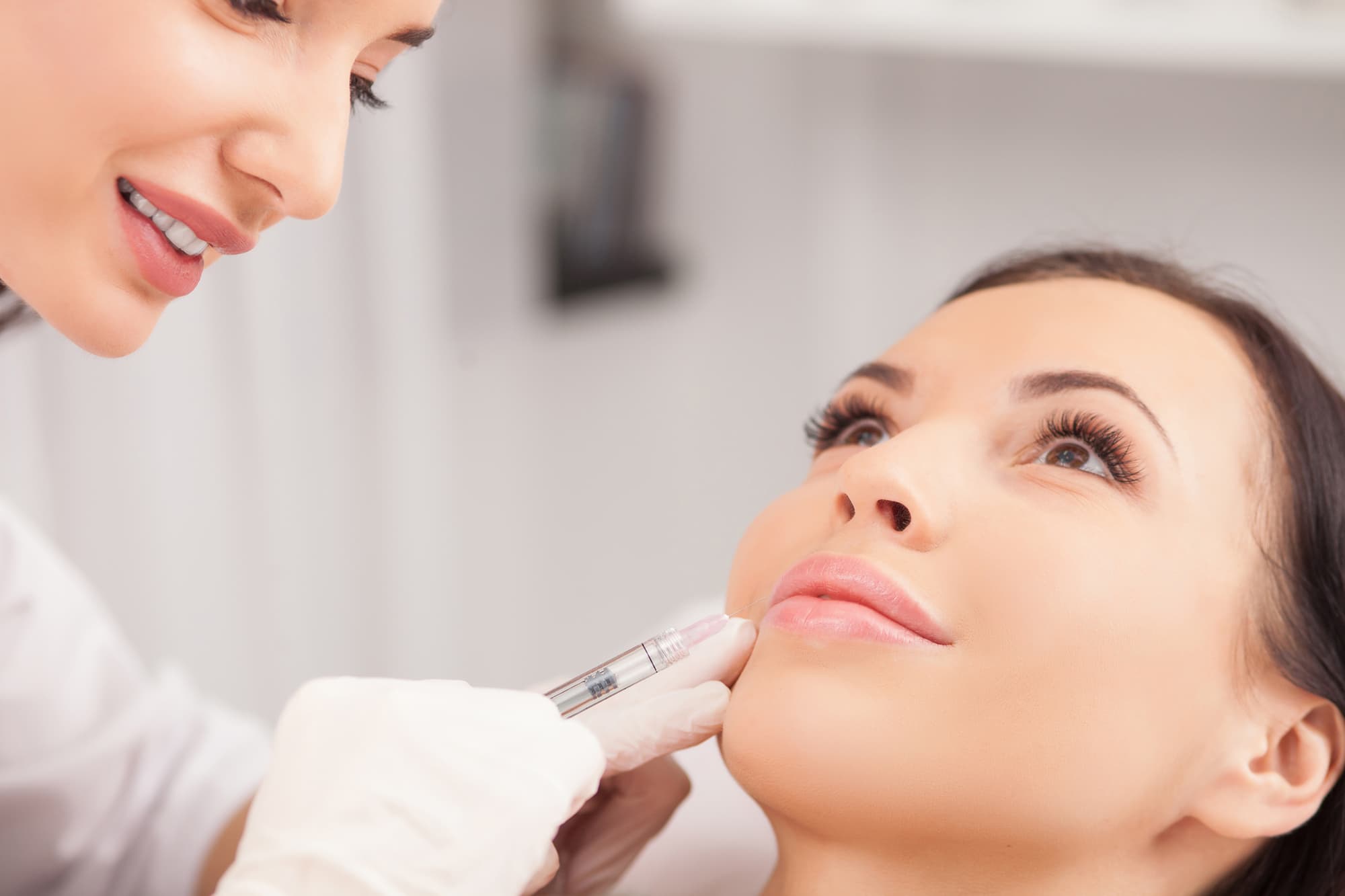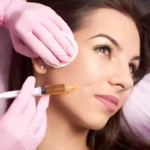

Botox is globally one of the most well-known products in cosmetics. An injectable solution that provides excellent results in a matter of days is one of the first choices people make when getting a non-surgical facelift. Today, we will discuss the use of Botox for smile lines and the benefits and risks involved in the procedure. In this article, you will also learn how the procedure compares to dermal fillers; and which is a better choice for your patients.
What Are Smile Lines?
Nasolabial folds, commonly known as smile lines or laugh lines, are wrinkles from the bottom of the nose to the corners of the mouth. They appear as we age and are common in both men and women.
Despite popular opinion, smile lines aren’t more prominent in any gender or race. While they get deeper and more visible with age, genetics and collagen production play the most significant part in how much an individual is prone to getting these wrinkles. Generally, after the age 25, a person can expect to notice these lines forming, as that’s roughly the time when natural collagen production slows down.
The biggest causes of nasolabial folds are sun damage and smoking. Gaining or losing weight faster can accentuate the smile lines, but aging is the most prominent cause.
Botox Treatment for Smile Lines
Treatment for smile lines is possible, and today there are many methods for revitalizing the skin around this area. One of the most popular methods is with botulinum toxin, or Botox as it’s more commonly known.
Botox is an injectable drug widely used to rejuvenate different areas of the face. It’s FDA-approved and very potent, restoring volume to the treated area, including the smile lines. It has also been used to treat various medical conditions like migraines and neck spasms.
Since Botox is an injectable product, treating smile lines with Botox is done through a non-invasive and non-surgical procedure. Little preparation is required, and the whole process takes less than half an hour.
How Botox for Smile Lines Works
As we’ve previously mentioned, Botox is an injectable product. The medical professional, a dermatologist or a plastic surgeon, inserts the product using a fine needle, targeting the muscle tissue underneath the skin.
Once injected, Botox relaxes the muscles in the treated area. This then causes tightening of the skin’s surface, smoothing it out and causing the smile lines to become less prominent.
The effect isn’t immediate, though. It usually takes three to five days for Botox to reach its full potential, and, in most cases, one procedure is enough to make the smile lines disappear.
The doses used for smile lines are significantly smaller compared to using Botox on the forehead area. A typical dosage involves 3 to 6 units per side, so a single appointment costs between $300 and $600.
It’s important to note that Botox doesn’t last indefinitely. The effects of Botox on smile lines last up to six months. Repeated procedures are necessary if the patient wishes to keep their new look over an extended period.
Benefits of Botox Treatment for Smile Lines
Patients decide to get Botox for several reasons, but especially for their smile lines.
Foremost, the procedure is quick and painless. After the medical practitioner numbs the area with topical anesthetic, the patient won’t feel the Botox injection. And it’s all done in about 15 to 20 minutes, allowing the patient to continue with their daily routine afterward.
The recovery period is just 24 hours. While those 24 hours are crucial and involve some precautions and changes to one’s routine, that’s it regarding aftercare.
The cost of getting Botox for smile lines is relatively low, usually only $600, and even that is in rare cases when the folds are highly exaggerated. Since the effects last for three to six months, the “maintenance costs” aren’t high, allowing more people to get their smile lines corrected.
And, lastly, it works. Botox relaxes the muscles in this area, and the patient will see the procedure’s results within a few days.
Risks and Side Effects of Botox Treatment for Smile Lines
Botox remains a type of toxin with certain precautions and risks to consider. Most importantly, only trained, licensed medical personnel should administer Botox injections.
Proper injection technique is also essential, so the patient doesn’t suffer any pain or bruising in the treated area. This also ensures that Botox is evenly distributed throughout the muscle tissue.
The potential side effects of these injections for smile lines are:
- – Headache
- – Flu-like symptoms
- – Redness in the treated area
- – Nausea
- – Drooping and facial weakness
- – Bruising and pain at injection sites
Allergic reactions to Botox are rare but still possible even when used in such small doses. Hence, the importance of consultations with the patient before they undergo the procedure.
Additionally, certain people aren’t good candidates for Botox. These include pregnant or breastfeeding women, people suffering from severe reactions to injections, or if the patient has an infection at or near the treatment site.
The first 24 hours after injecting Botox around the mouth are when the patient should take the most care. Patients should avoid exercise and other strenuous activities during this period and also avoid consuming alcohol, nicotine, sugar, and salt. To avoid bruising, the patient shouldn’t rub the treated area and minimize exposure to the sun as much as possible.
Another thing to note is that the patient should avoid certain foods and products before the Botox treatment. This includes:
- – Nicotine
- – Caffeine
- – Alcohol
- – Blood-thinning medications
- – Any supplements that affect blood-clotting
- – Foods rich in antioxidants
These products should be avoided for two weeks before the scheduled appointment.
Botox vs. Fillers for Smile Lines
When treating smile lines, Botox and dermal fillers are the most common options. But which one is a better choice and which is more effective?
At a glance, they are very similar. They’re both injectables and non-invasive, restoring one’s youthful appearance. But, the indications aren’t the same, nor are their effects’ longevity.
Botox is mainly used to treat fine lines and wrinkles caused by facial expressions like smiling and frowning.
Dermal fillers, on the other hand, are meant to restore facial volume. They can also correct facial asymmetry and certain conditions like scars.
One significant difference is that dermal fillers are based on hyaluronic acid, a substance naturally produced by the human body. It’s an organic alternative for people unsure about getting Botox for laugh lines.
Regarding results, both products are very effective in treating smile lines; dermal fillers, however, produced proved a longer-lasting effect – up to 18 months compared to the 6 months that Botox lasts.
FAQ
Is Botox or filler better for smile lines?
Although Botox has been the injection of choice for many years, it’s recommended now to inject dermal fillers into the smile lines. The downside of using Botox in this area is that it may cause a “duck face” lip by lengthening the distance between the nose and mouth.
How many units of Botox are needed for smile lines?
Typically, this procedure requires 3 to 6 units of Botox. The exact amount depends on the skin’s elasticity, the patient’s age, and the desired effect.
What is the best treatment for smile lines?
Using Botox for smile lines remains the best choice alongside hyaluronic-based dermal fillers. These are also one of the few non-surgical procedures that proved highly effective and provided natural-looking results.
References
Botulinum toxin (Botox) A for reducing the appearance of facial wrinkles: a literature review of clinical use and pharmacological aspect; Bagus Komang Satriyasa, Apr 2019
https://www.ncbi.nlm.nih.gov/pmc/articles/PMC6489637/
The Effect of Botulinum Toxin Injections on the Nasolabial Fold; Nov 2003
https://www.researchgate.net/publication/9085666_The_Effect_of_Botulinum_Toxin_Injections_on_the_Nasolabial_Fold
The effect of botulinum toxin injections on the nasolabial fold; Michael A C Kane, Oct 2003
https://pubmed.ncbi.nlm.nih.gov/14504487/
Tissue Fillers for the Nasolabial Fold Area: A Systematic Review and Meta-Analysis of Randomized Clinical Trials; Tomasz Stefura, Artur Kacprzyk, Jakub Droś, Marta Krzysztofik, Oksana Skomarovska, Marta Fijałkowska, and Mateusz Koziej, Jul 2021
https://www.ncbi.nlm.nih.gov/pmc/articles/PMC8481177/
Aesthetic products generally refer to a broad category of items designed to enhance or improve one's appearance, often focusing on skincare, beauty, and personal grooming. These products are typically used to maintain or enhance physical attractiveness and may include a wide range of items intended for both professional and personal use. Here are some common types of aesthetic products:
-
Skincare Products: Including cleansers, moisturizers, serums, and treatments designed to address various skin concerns such as acne, aging, hyperpigmentation, and sensitivity.
-
Cosmetics: Makeup products such as foundations, concealers, eyeliners, lipsticks, and eyeshadows used to enhance facial features and achieve desired looks.
-
Hair Care Products: Shampoos, conditioners, styling products, and treatments to maintain and improve the health and appearance of hair.
-
Fragrances: Perfumes and colognes used to enhance personal scent and attractiveness.
-
Dental Care Products: Toothpaste, mouthwash, whitening treatments, and dental floss aimed at maintaining oral hygiene and enhancing smile aesthetics.
-
Personal Grooming Tools: Including razors, electric shavers, trimmers, and grooming kits used for hair removal and personal hygiene.
-
Beauty Devices: Devices such as facial cleansing brushes, LED light therapy masks, and microcurrent devices designed for at-home skincare treatments.
-
Nutritional Supplements: Supplements aimed at promoting skin health, hair growth, and overall well-being, often containing vitamins, minerals, and antioxidants.




